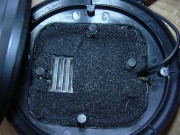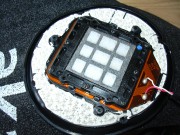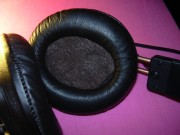leeperry
Galvanically isolated his brain
- Joined
- Apr 23, 2004
- Posts
- 13,823
- Likes
- 1,685
There's a lot of ppl deeply into headphones cups damping on this forum...how do you guys work out whether your're listening to the cups resonances "back-wave distortion" or to the music "untouched" reverb?
Ideally it'd take a very dry reference recording and judge by ear?
There seems to be a very thin line between perfect damping and overdamping. The latter will sound muffled and claustrophobic(like a tiny anechoic room), and a lack of damping will sound like a massive amount of nasty sounding "back-wave distortion" that colors the sound in a pretty unbearable way, killing the smallest details due to the increased THD...picture what an aluminium lined cup does(very metallic/agressive trebles) and you'll get an idea of what I'm trying to convey. OTOH, AT regularly use metal cups...hopefully they're damped

Many legendary headphones are based on those very cups resonances, and Beyer uses ABS on its Premium line(and so does SONY on the sa3k/5k)...that is widely used in music instruments due to its great sounding resonances, which leads to my real question: cups act as room walls, don't they? Or should we damp them to suppress those resonances? Which leads again to the fact that Beyer/SONY use ABS, and Sony used some vegetal/plastic hybrid cups on the cd3k.
Wooden cups have a god-like magical aura on this forum, but wood often has a very poor damping factor: http://qualia.webs.com/dampingfactorvalues.htm
I believe Dynaxorb does exactly what we want:

It seems that you can't really beat petroleum based matters for acoustic damping, as they both absorb a great deal of energy and break the back-waves all at once. Wood cannot do that as effectively IMO.
I don't think any sane loudspeaker designer would decide to keep inner-cabinet resonances on purpose? But do loudspeakers and headphones aim at the same goal? Can all reflections be considered as parasiting the SQ? Music instruments need to resonate, it would appear that headphones do not..except if the cups are supposed to act as room walls do for loudspeakers..I'm sure listening to music in a true anechoic room must be a tad disturbing to the human brain?
Talking about anechoic rooms, this crossfeed plugin tries to mimic one...it's not really a "mono-izing" DSP and it's not a reverberating room simulator either. It's a "dry" reverb so to speak...it does sound kinda weird, yet you can read this kind of (supposedly) end-user testimonial:
Need to chew on this, feel free to share your thoughts if you like

Ideally it'd take a very dry reference recording and judge by ear?
There seems to be a very thin line between perfect damping and overdamping. The latter will sound muffled and claustrophobic(like a tiny anechoic room), and a lack of damping will sound like a massive amount of nasty sounding "back-wave distortion" that colors the sound in a pretty unbearable way, killing the smallest details due to the increased THD...picture what an aluminium lined cup does(very metallic/agressive trebles) and you'll get an idea of what I'm trying to convey. OTOH, AT regularly use metal cups...hopefully they're damped

Many legendary headphones are based on those very cups resonances, and Beyer uses ABS on its Premium line(and so does SONY on the sa3k/5k)...that is widely used in music instruments due to its great sounding resonances, which leads to my real question: cups act as room walls, don't they? Or should we damp them to suppress those resonances? Which leads again to the fact that Beyer/SONY use ABS, and Sony used some vegetal/plastic hybrid cups on the cd3k.
Wooden cups have a god-like magical aura on this forum, but wood often has a very poor damping factor: http://qualia.webs.com/dampingfactorvalues.htm
I believe Dynaxorb does exactly what we want:

DynaXorb absorbs, diffuses and attenuates the sonic energy directed towards it
[size=xx-small]Back wave distortion, a common problem with every speaker, occurs when your speaker sends the same sound out the back as it does out the front! If this rear sound wave energy is allowed to bounce back and return to the speaker, it interferes with the speaker’s ability to operate properly causing back-wave speaker distortion. [/size]
It seems that you can't really beat petroleum based matters for acoustic damping, as they both absorb a great deal of energy and break the back-waves all at once. Wood cannot do that as effectively IMO.
I don't think any sane loudspeaker designer would decide to keep inner-cabinet resonances on purpose? But do loudspeakers and headphones aim at the same goal? Can all reflections be considered as parasiting the SQ? Music instruments need to resonate, it would appear that headphones do not..except if the cups are supposed to act as room walls do for loudspeakers..I'm sure listening to music in a true anechoic room must be a tad disturbing to the human brain?
Talking about anechoic rooms, this crossfeed plugin tries to mimic one...it's not really a "mono-izing" DSP and it's not a reverberating room simulator either. It's a "dry" reverb so to speak...it does sound kinda weird, yet you can read this kind of (supposedly) end-user testimonial:
I have reached a point with Redline Headphone Monitor that I can no longer do headphones without it. It just sounds SO much more like my speakers.
Need to chew on this, feel free to share your thoughts if you like



.gif)






